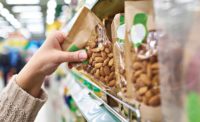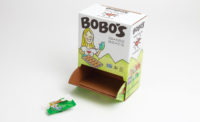Snack and bakery packaging materials go green
The latest packaging research and innovations target sustainability.

New research and innovations in packaging materials are focused on sustainability, which is important for bakery and snack producers who strive to achieve green solutions in their everyday packaging operations. Sustainability also is a key concern for consumers who prefer materials made from recycled materials.
The green frontier
The next frontier in sustainability is the biodegradable and compostable market, says Maria Ferrante, senior director, marketing and communications, PMMI, Herndon, VA. In fact, one in four brand owners is exploring renewable packaging by testing plant-based and bio-based options, according to PMMI’s “Packaging Sustainability: A Changing Landscape” report.
“These plant-based resin materials also are ideal for use in modified-atmosphere packaging (MAP) applications,” Ferrante says. “Of course, companies must consider factors such as: Does the new material run as fast as conventional materials? Will the new material limit the machine’s flexibility? What machine modifications might be needed to accommodate new materials?”
PRISM (plastic packaging recycling using intelligent separation technologies), another sustainability initiative, offers is a new way to sort packaging for recycling. PRISM applies luminescent materials to labels on plastic packaging, creating an invisible bar code for plastics recycling. Packaging marked with intelligent labels of coatings can be uniquely identified and sorted with high efficiency using commercial equipment.
“PRISM is now well-proven in material recovery facilities and is plug-and-play ready,” Ferrante explains. “It is complementary to existing near-infrared optical sorting technology and can be adapted to most sorting facilities around the world to target specific recycling streams, such as food-contact plastic packaging.” Trials have been completed with recycling organizations and brand owners in Europe, and the next stages of commercialization are in progress.
Kwik Lok Corp., Yakima, WA, has joined the U.S. Plastics Pact, a green initiative rooted in four goals intended to drive change and create a path toward a circular economy for plastics in the U.S. The goals are:
-
Define a list of packaging to be designated as problematic or unnecessary by 2021 and take measures to eliminate them by 2025
-
Make all plastic packaging 100 percent reusable, recyclable, or compostable by 2025
-
Undertake actions to recycle or compost 50 percent of plastic packaging by 2025
-
Make the average recycled content or responsibly sourced bio-based content in plastic packaging 30 percent by 2025
“As a member of the U.S. Pact, Kwik Lok joins more than 70 brands, retailers, non-governmental organizations, and government agencies across the plastics value chain to bring one voice to U.S. packaging through coordinated initiatives and innovative solutions for rethinking products and business models,” says Don Carrell, CEO, Kwik Lok. The U.S. Pact is led by The Recycling Partnership, World Wildlife Fund (WWF), and Ellen MacArthur Foundation.
In another sustainability initiative, researchers at Purdue University, West Lafayette, IN, have created a manufacturing process that uses cellulose nanocrystals (CNCs) as advanced barrier coatings for food packaging. The research is ongoing. “This technology offers a way to make high-performance barrier layers from a sustainable, renewable, biodegradable material that replaces petroleum-derived materials of limited degradability,” says Jeffrey Youngblood, professor, School of Materials Engineering. “The multi-material design of many of today’s packaging solutions is a primary factor that prevents recycling, composting, and biodegradation. Widespread adoption of innovations such as CNC packaging could drive real sustainability, because it would negate mixed material issues and facilitate recycling and composting.”
Vendor innovations
Many packaging materials recently introduced to the bakery and snack market are designed to meet sustainability initiatives. Fabio Peyer, director of sustainability, Amcor Flexibles North America, Oshkosh, WI, says that over the last two years, recyclability has emerged as the No. 1 trend in packaging sustainability with no sign of abating.
In response, the company has introduced the AmPrima portfolio of polyethylene-based flexible packaging solutions designed for recyclability across the U.S. and Canada. AmPrima reportedly is suitable for a variety of formats and applications, including flow-wraps, pouches, and bags. It offers a high level of clarity and machinability and can rival incumbent non-recyclable solutions.
“Also, AmPrima is one of the few flexible packaging solutions that have received pre-qualification from the Sustainable Packaging Coalition for a How2Recycle label. This pre-qualification expedites the labeling process for brand owners, while reducing cost and risk in the developmental phase,” Peyer says.
Amcor Flexibles North America also is developing packaging solutions that are compostable, contain recycled content, and are paper-based to address a wide range of sustainability needs in the bakery and snack market, according to Lori Gobris, senior marketing manager. “We can incorporate those sustainability formats along with convenience features to create packaging that connects with consumers’ needs.”
When it comes to reducing food waste and extending shelf life, tight packaging seals are critical, according to Michelle Sauder, senior marketing manager, food and specialty packaging division, Dow, Midland, MI. She notes that Dow’s SURLYN has become a go-to option for flexible packaging formats such as pillow pouches, flow-wrap packages, and stand-up pouches. “Hermetic sealing and eliminating leakage in packaging is even more important from a sustainability aspect. Food waste, in most cases, has a much-higher impact on the environment than the packaging that protects it.”
The latest challenge that Dow is addressing is how to create packaging that provides necessary barriers and recyclability. For packaging that requires ethylene vinyl alcohol, Dow’s RETAIN 3000 was developed to enable the recyclability of these barrier films. “This allows converters and brand owners to meet their sustainability goals and keep waste out of the landfill while still meeting the packaging needs for bakery and snack products,” Sauder says.
Polyethylene resins from Dow are important tools that enable creation of mono-material, all-polyethylene film, adds Sauder. “These resins can optimize package design and performance by providing a combination of moisture barrier, toughness, and sealability.”
Sealstrip Corp., Gilbertsville, PA, has introduced VerdeSeal, a recyclable, pressure-sensitive tape technology that is FDA-compliant and applicable to the company’s easy-open and resealable product lines. Also, by utilizing recyclable polyethylene-based films, VerdeSeal meets the content requirements of the How2Recycle “Store Drop-Off” label and can be recycled wherever polyethylene film recycling streams are available.
“VerdeSeal is able to reduce the carbon footprint by 66 percent when compared to conventional reseal adhesive technologies,” says Jo Anne Forman, director of product development, Sealstrip Corp. “By down-gauging film thickness by 20 percent, using a patterned adhesive application, and continuing to integrate forthcoming sustainable materials, VerdeSeal offers recyclable solutions with a decreased environmental footprint.”
R.A Jones, Covington, KY, a manufacturer of food packaging machines, works directly with customers and their material suppliers to make sure new sustainable structures can be run on its equipment. The focus is to ensure that the sustainable packaging materials can maintain the current customer experience, which includes extending product shelf life. R.A Jones and Volpak are sister companies under Coesia.
“The challenges of running new sustainable materials on high-speed machines (up to 2,000 pouches per minute) include the deformation of material from the heat applied by sealing mechanisms,” says Ricky Low, portfolio manager, pouching and aerosol, R.A Jones. Thermal expansion or shrinkage of sustainable (less heat-tolerant) materials pose an array of challenges downstream in the system, such as dosing/filling of product and collating for secondary packaging.
To help its customers solve these challenges, R.A Jones engineers concepts specific to the film and product application, which allow snack and bakery producers to retrofit upgrades to their existing machines. “To address the material deformation, for example, new engineering designs can separate the heat source from the film or alternative heat sources for enhanced heat control,” Low says.
The industry has relied on using tried-and-tested solutions, such as MAP and barrier films, to achieve extended shelf life, according to Andrew Manly, communications director, The Active & Intelligent Packaging Industry Association (AIPIA), Utrecht, the Netherlands. “One bright spot has been the development of smart technologies, such as the Digimarc digital watermark, to identify different plastics that enable easier sorting for recycling. This is applicable to both rigid and flexible packaging used extensively in the baked goods sector.”
The main challenge to the development of flexible packaging remains the question of sustainability and recycling, Manly adds. He says many packaging suppliers are developing monomer films to replace laminates and more biopolymers or those that degrade quickly. In fact, food-grade recycled plastics could be available soon.
“But we must not lose sight of what the packaging is for,” Manly cautions. “It is to protect and preserve the product and reduce food waste, which is far more harmful to the environment than plastic packaging. It is easy to take a photograph of 100,000 bottles floating in the ocean, but not so easy or dramatic to show 1,000 tons of food waste being ploughed into a landfill.”
Looking for a reprint of this article?
From high-res PDFs to custom plaques, order your copy today!





